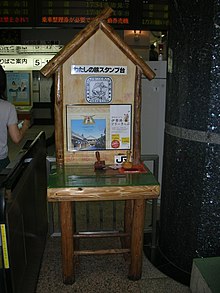
An eki stamp (駅スタンプ, train station stamp) is a free collectible rubber ink stamp, which is found at many train stations in Japan and Taiwan.[1] Their designs typically feature imagery emblematic of the station's associated city or surrounding area, such as landmarks, mascots, and locally produced goods. A time-limited event involving eki stamps pertaining to a specific theme, especially a collaboration with a product of Japanese popular culture, is often called a stamp rally.[2]
Some suggest eki stamps were inspired by the success of shuinchō stamp books.[2] Eki stamps have existed since at least 1931, when one was installed at a station in Fukui[3] and shortly thereafter, eki stamps were installed at major stations throughout Japan. These stamping stations are equipped with collectible rubber ink stamps featuring unique designs representing the station's city or its surrounding attractions. Travelers can use their own notebooks or stamp books to collect these stamps, making it a pleasant way to document their journey.[4] Today, eki stamps exist at nearly all staffed train stations in Japan. Eki stamps also commonly exist at other passenger points of boarding like subway stations, airports, ports, and highway service areas.